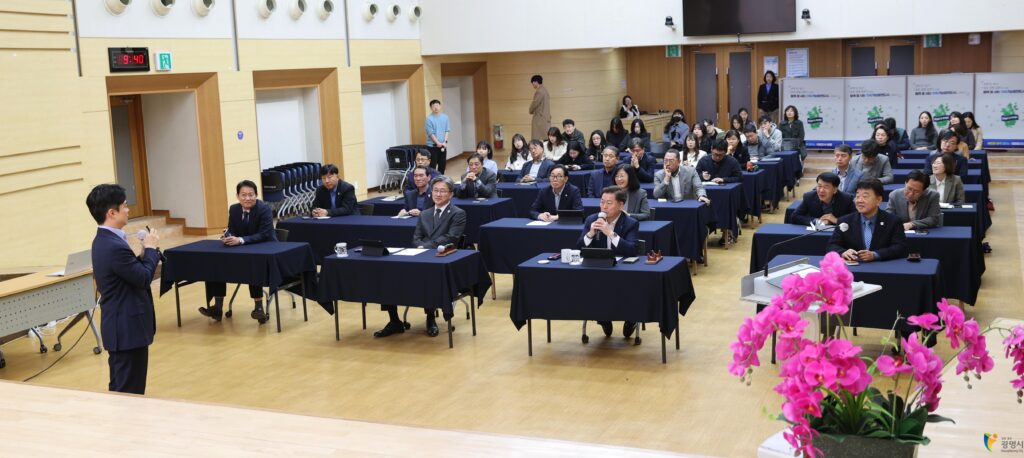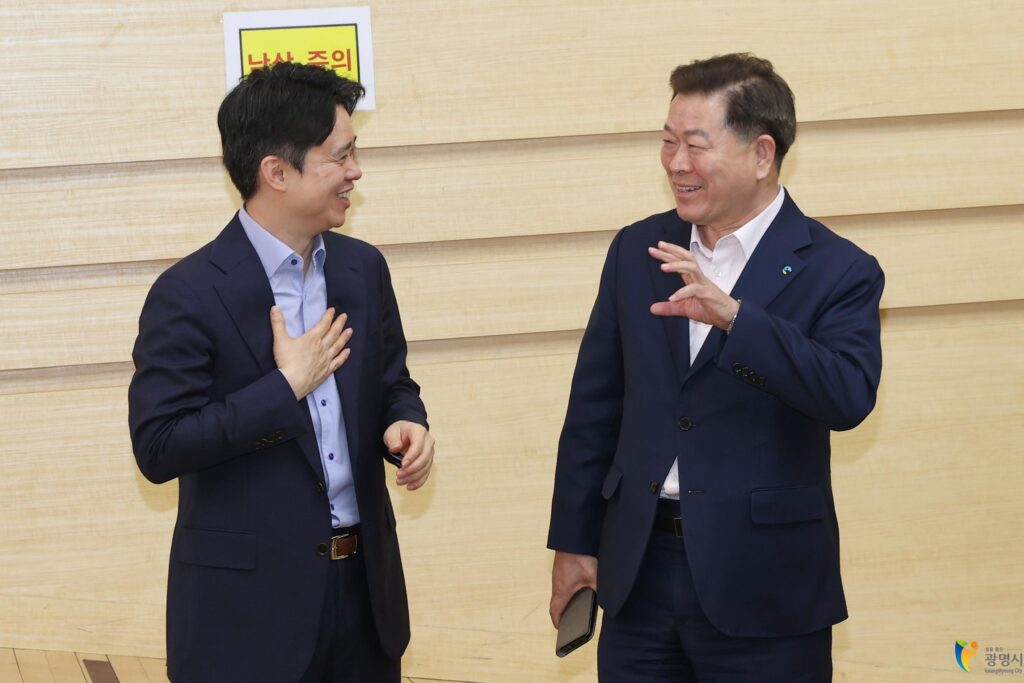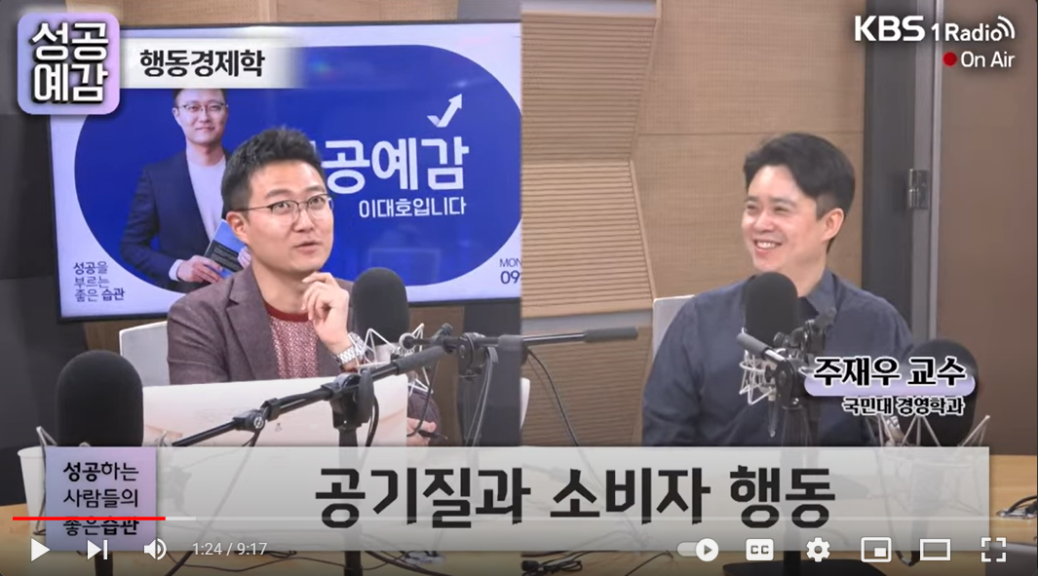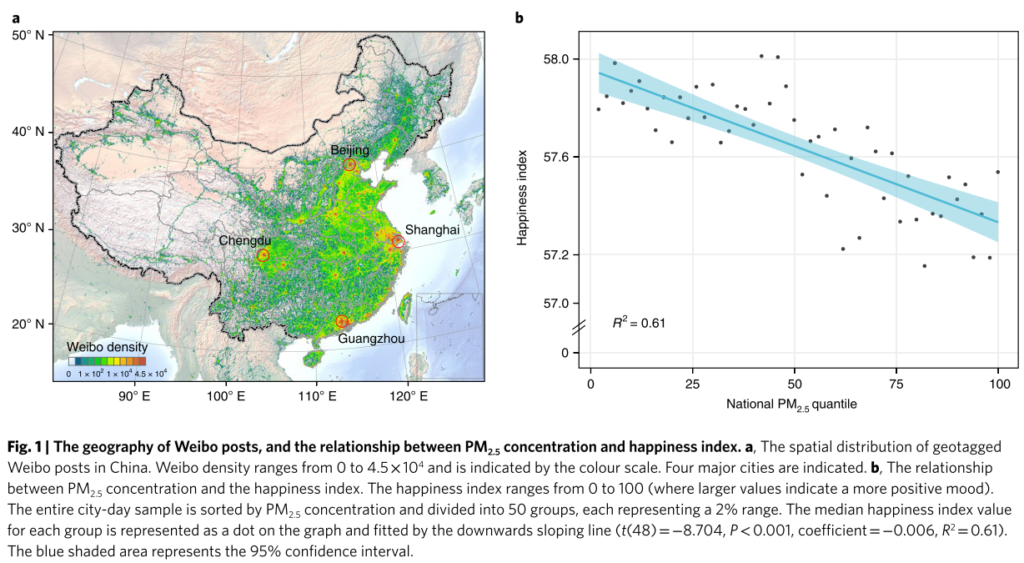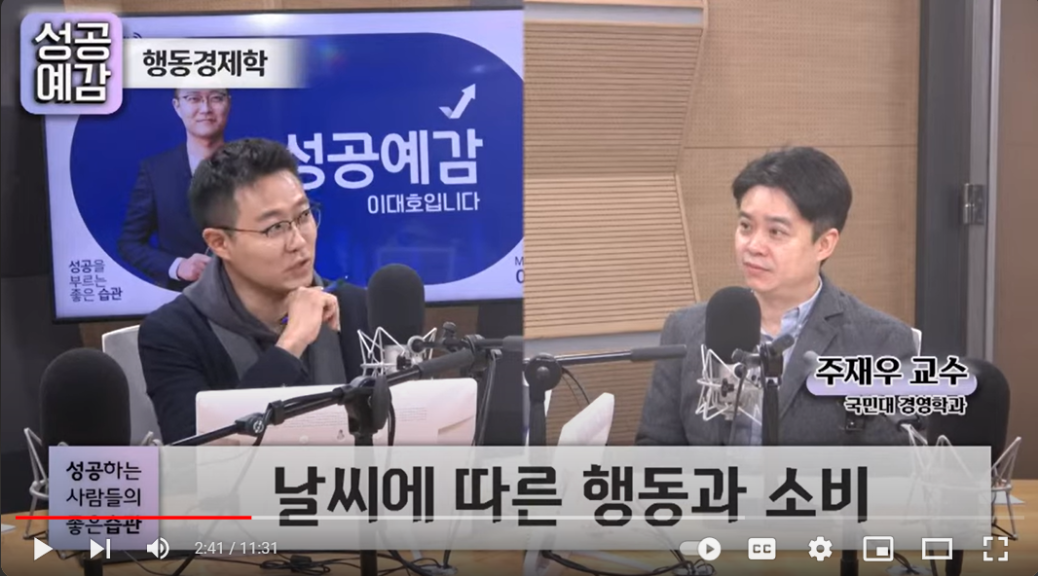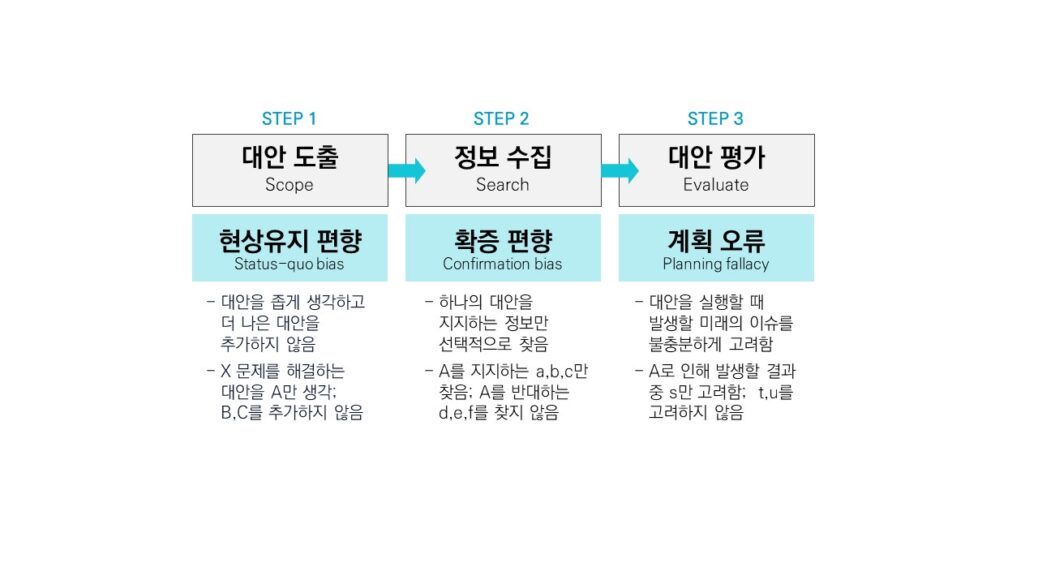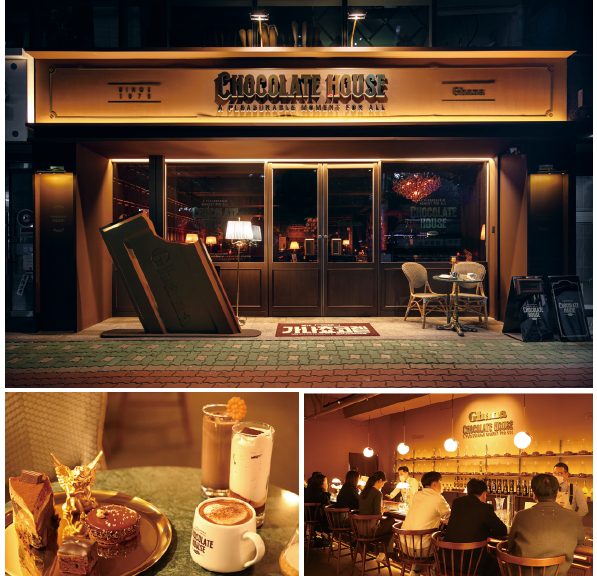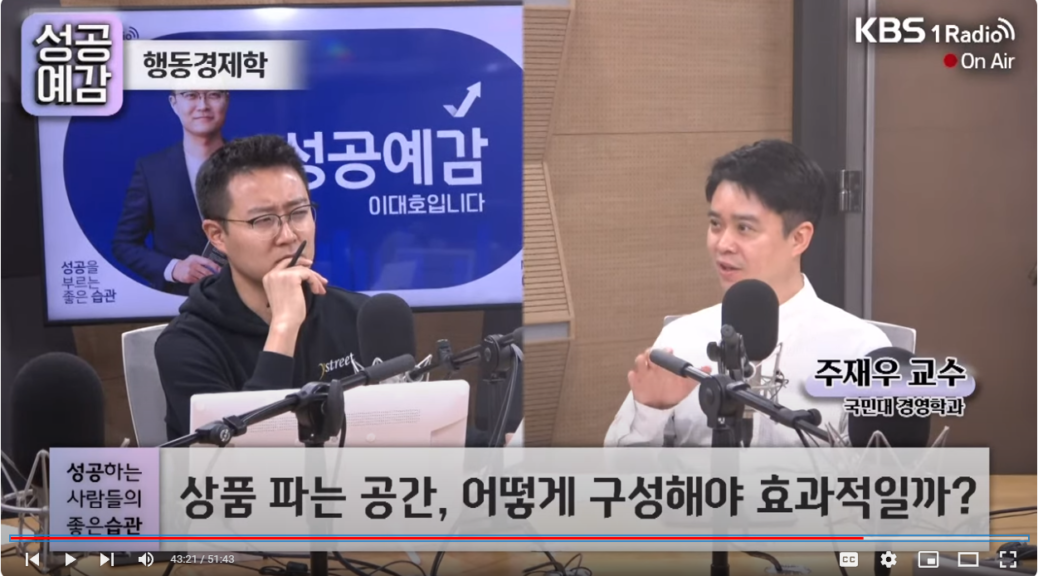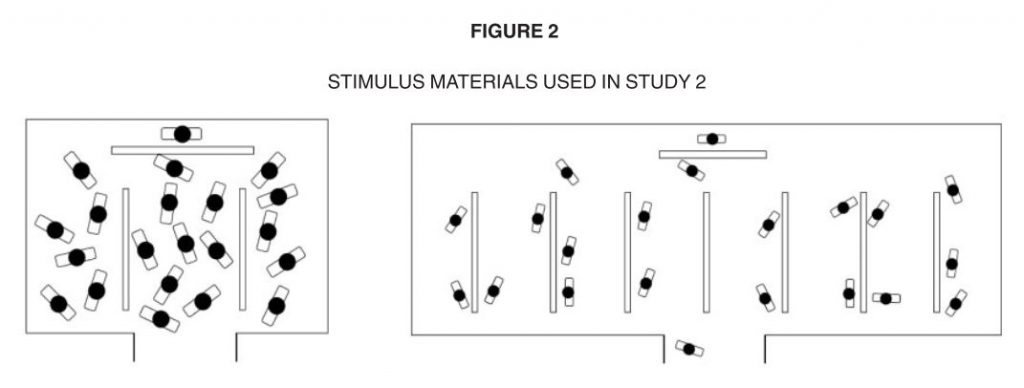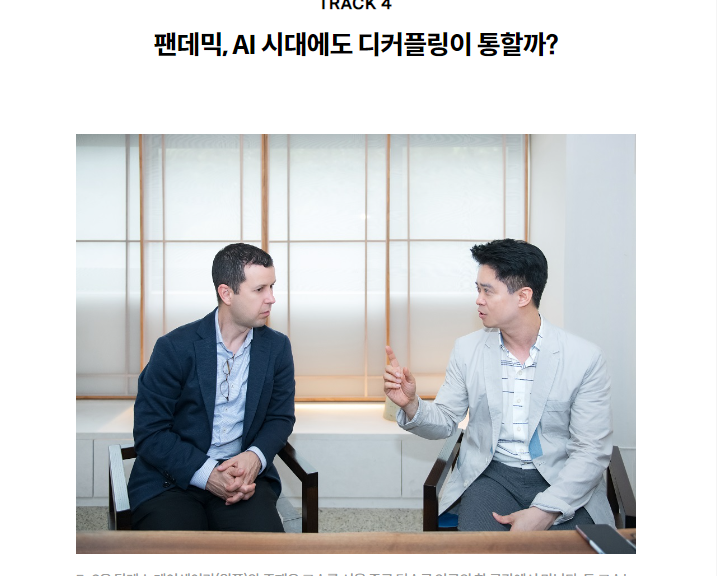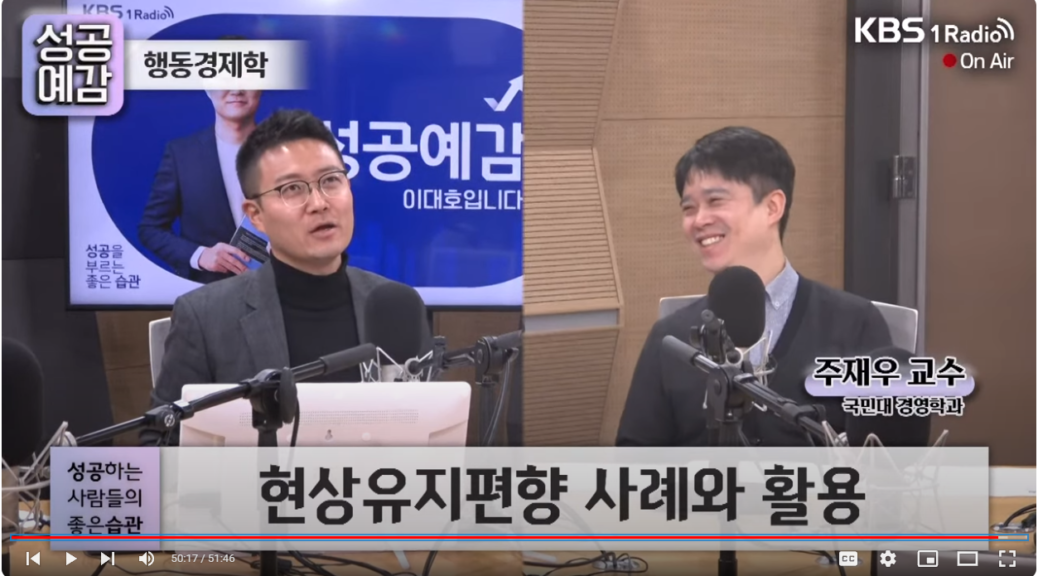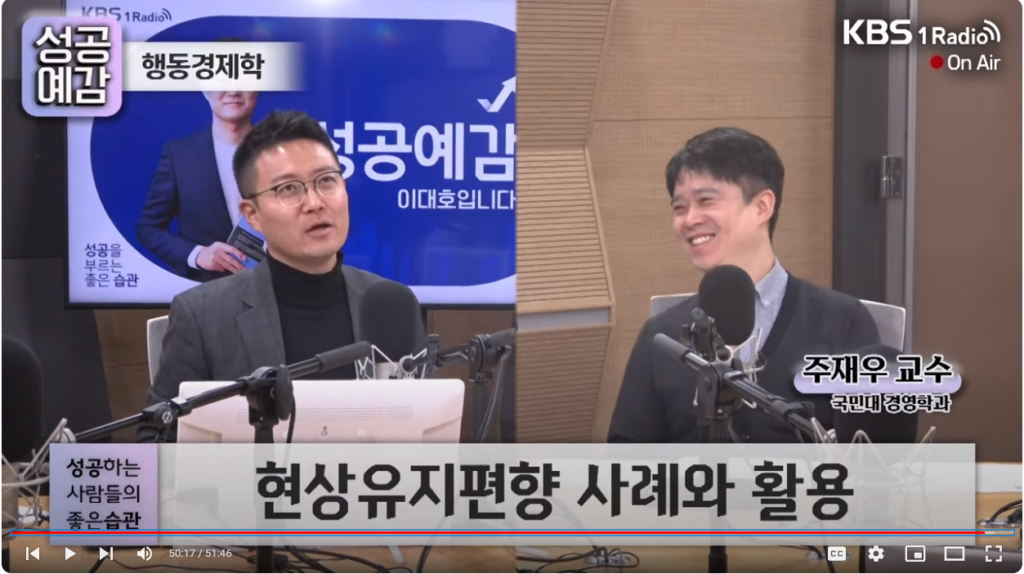“서비스 혁신 기획안을 도출할 때는 나중에 해야 할 일이 가장 적을 것 같은, 또는 주변의 저항이 가장 적을 것 같은 기획안을 주로 도출합니다. 그리고 그 기획안의 강점을 지지할 만한 데이터를 찾아서 더하고, 그 기획안에 필요한 일 중에서 당해 연도에 성과가 날 수 있는 일만을 중점적으로 선택합니다.” (R사 상품기획)
기업의 직원이나 창업가로서 일하는 사람이라면, R 사의 상품기획 사례에서 언급된 특유의 비합리성을 몸으로는 받아들이더라도 머리로 받아들이기 어려운 경우가 많다. 과연 하나의 기획안이 도출되고, 지지되고, 실행되는 비즈니스 의사결정에서 인간이 보여주는 비합리성은 정확하게 무엇일까?
의사결정 단계
주어진 문제를 해결하는 의사결정은 총 3단계를 거친다. 첫 번째, 대안 도출 단계에서는 주어진 문제를 해결할 수 있는 복수의 대안을 찾고, 두 번째 정보수집 단계에서는 각 대안을 지지하거나 반대하는 근거를 수집한다. 세 번째, 대안 평가 단계에서는 복수의 대안이 펼쳐질 결과를 예상해서 하나의 대안을 최선의 대안으로 선택해야 한다.
각 단계에서 해당 업무가 충실하게 이행되어야만 최종적으로 합리적인 의사결정이 이루어진다. 하지만 모든 인간은 인지적으로 게으르기 때문에 의사결정을 내릴 때 휴리스틱(Heuristic)이라는 심리적 지름길에 의존한다. 즉, 빠르게 결론에 도달하기 위해 정확성을 포기하기 때문에 편향된(Biased) 의사결정을 내리는 경우가 많고, 이는 비합리적인 의사결정이 된다. 앞서 살펴본 의사결정 3단계에서 나타나기 쉬운 편향과 사례를 조금 더 구체적으로 살펴보자.
의사결정 단계별 편향
1. 대안 도출 단계에서는 현상 유지 편향(Status-quo bias)이 나타나기 쉽다.
사람들은 문제가 발생했을 때 저항이 가장 적은 방식으로 문제를 해결한다. 저항이 가장 적은 방식은 최초 대안으로 떠오르는 것을 바로 해결책으로 적용하는 것이다. 따라서 사람들은 하나의 대안이 떠오르면 추가 대안을 생각하지 않는 경향이 있다. 예를 들어, 저녁 식사 메뉴를 고려할 때 최초 대안으로 ‘도미노 피자에 주문하자’가 떠오르면, 다른 대안에 대한 고민 없이 바로 전화를 걸어서 피자를 주문한다.
“파트너사를 선정할 때 주로 3개 업체가 최종에 남습니다. 아무리 가격이 저렴하더라도, 아무리 기술력이 좋더라도, 기존에 거래했던 업체보다 더 적정한 업체라는 평가를 받기가 어렵습니다. 가격도 기술력도 중요하지만, 그동안 나눈 이야기를 이해하는 것이 더 중요하게 느껴집니다.” (K사 개발)
2. 정보수집 단계에서는 확증 편향(Confirmation bias)이 나타나기 쉽다.
사람들은 가설을 엄정하게 검증하지 않고 섣부르게 검증하는 경향이 있다. 가설과 어긋나는 근거를 가지고 가설을 부정적으로 검증하기보다는, 가설과 일치하는 근거로 가설을 긍정적으로 검증하기를 우선한다. 따라서 사람들은 특정 대안을 지지하는 정보만 선택적으로 찾고, 특정 대안을 지지하지 않는 정보는 의식적으로 무시하거나 무의식적으로 찾지 않는다. 예를 들어, 여러 방향으로 해석이 가능한 애매모호한 정보는 기존 선호도에 부합하는 방향으로 해석하고, 주관적 경험은 광고에 부합하는 방향으로 해석하는 것이다.
“상사가 좋다고 추천한 후보를 검증할 때는 정보수집 단계에서 이미 고정관념을 갖게 되는 경우가 많습니다. 실제로 저연차 구성원이 해외 법인에 관해 의견을 물었을 때는 신랄하게 비판했으나, 나중에 사장님의 아이디어라는 사실이 밝혀지자 모두가 적극 찬성하는 기조로 바뀐 경우가 있습니다.” (P사 마케팅)
“시황이 변동될 때를 대비해서 일부 선물 거래를 통해 리스크를 hedge해야 합니다. 하지만 현재 가격이 좋을 경우, 앞으로도 계속 좋을 것이라는 예상하에 합리적인 hedge를 하지 못해 나중에 크게 손해 보는 경우가 있습니다.” (M사 석유/화학)
3. 대안 평가 단계에서는 계획 오류(Planning fallacy)가 나타나기 쉽다.
사람들은 미래의 효용과 비용을 올바르게 예측하지 못한다. 현재에 지나치게 큰 비중을 두고 미래에 펼쳐질 일을 충분히 고려하지 못하기 때문이다. 실제로는 미래의 비용이나 이익이 매우 크지만, 당장의 작은 비용 또는 이익을 확대해서 보는 경향이 있다.
따라서 사람들은 계획을 수립할 때 과거의 유사한 과업 경험에 대한 지식을 활용하지 않고, 가장 긍정적인 시나리오에만 초점을 맞춘다. 예를 들어, 대학생들에게 과제물 작성에 소요되는 시일을 예상하도록 했을 때 예상 평균치가 33.9일이 나왔다. 최상의 시나리오일 경우 예상 평균치가 27.4일, 최악의 시나리오일 경우 예상 평균치가 48.6일이었다. 그러나 실제 과제물 완성에 소요된 평균 일수는 55.5일로, 약 30%의 학생들만이 본인이 예상한 기간 내에 과제물을 완성했다. 이러한 사례는 호주의 오페라하우스 건립 과정에서도 발견되었다.
“신기술을 적용하는 개발 프로젝트를 고민할 때는, 모두가 모여서 여러 신기술이 적용될 때의 장단점을 자유롭게 언급합니다. 하지만 특정 기술을 적용하기로 한번 결정을 내리면, 프로젝트의 진행 도중 예전에 언급된 신기술의 단점을 깨달아도 이미 진행된 프로젝트를 멈추거나 뒤집기는 어렵습니다.” (B사 개발)
의사결정 단계별 편향 극복
특정한 사람만이 모든 문제에 대해 항상 비합리적인 의사결정을 내리는 것이 아니라, 모든 인간은 일정한 정도로 비합리적인 측면이 있다. 즉, 의사결정 단계별로 발견되는 편향을 극복하고 의사결정을 합리적으로 개선하기 위해서는, 인간이 가진 특유의 생각 방식을 깊게 이해한 뒤 개인의 합리성을 유도하는 전략적인 접근이 필요하다. 이러한 접근법으로는 규범적 학문인 경제학과 설명적 학문인 심리학을 접목하여 인간의 행동을 유도할 수 있는, 행동경제학이 하나의 대안이 될 수 있다.
